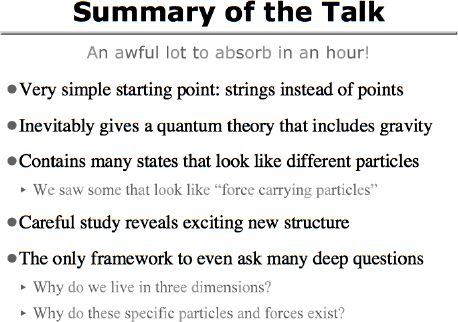In the end, despite the difficulty of finding experimental tests, string theory does seem very promising. We have seen that its simple premise leads to many features of the world we know, such as gravity and string states that look like a variety of other "particles". (The particles that we've discussed have all been force carrying "bosons" like gravitons and photons, but in superstring theory we find "fermions" like those that compose ordinary matter, too.)
And we have seen that the theory is a very rich one, where exploring seemingly simple questions like small extra dimensions can reveal fascinating new structure like T-duality and D-branes. That gives some hope that a deeper understanding of the theory really could lead to specific predictions about the observable world, from broad predictions like our three large dimensions of space to very specific predictions like the complicated "gauge group" and particle content of the Standard Model.
Even if string theory does not turn out to predict all of those details explicitly, there is great hope that it will at least provide a framework in which they could consistently exist. And at least for now, that is more than any other proposed theory of physics out there can say.
Up to my research page.
Up to my professional page.
My personal site is also available.
Any questions or comments? Write to me: jensens@alma.edu
Copyright © 2004 by Steuard Jensen.
